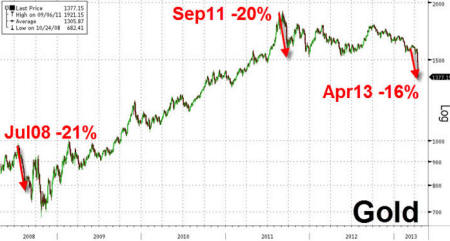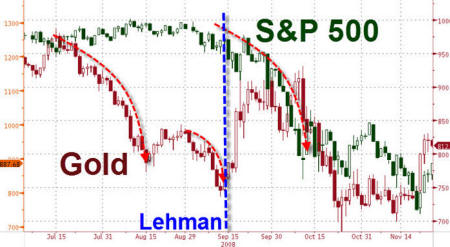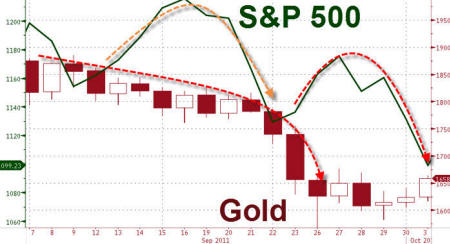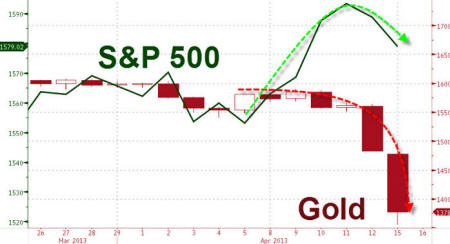
by WashingtonsBlog
April 15, 2013
from
WashingtonsBlog Website

Why Is Gold Crashing?
Gold has fallen off a cliff. It has fallen
faster than at any time in the last
30 years.
Zero Hedge
notes:
Adding insult to injury, the Shanghai Gold
Exchange overnight announced that following the tumbling precious metal
prices and limit down drop in early trading, it may raise trading
margins for its gold and silver forward contracts.
Raising margin requirements tends to trigger
further selling. (Update: CME has
also raised margin requirements.)
Some Say It Is a Good Time to Buy
While most financial advisers are screaming
“sell!”, there are some well-known contrarians.
For example,
Bill Gross still recommends buying
gold.
Marc Faber
says:
“I love the fact that gold is finally
breaking down because that will offer an excellent buying opportunity”
…. “The bull market in gold is not completed.”
John Hathaway of Tocqueville Funds (with
$10 billion under management)
says that the selloff in gold is “a contrarian’s dream scenario”:
The evidence shows strong macro fundamentals
for gold, investor sentiment at a negative extreme and compelling
valuations in the mining shares. It seems like a contrarian’s dream
scenario to us.
And Zero Hedge notes that - from the perspective
of technical analysis - gold is the
most oversold it has been in 14 years.
The Bearish Explanation
But why has gold crashed?
Bloomberg
blames:
-
“Optimism that a U.S. recovery will curb
the need for stimulus”; and
-
“The prospect that beleaguered members
of the euro zone might be forced to sell gold to raise part of the
funding, and there are much bigger holders in that category than
Cyprus.”
Citigroup
opines:
Gold decline may have been related to some
break in technical levels and the general improvement in global risk
appetite.
CNN
theorizes:
Monday’s broad decline was sparked by
slowing growth in China. The world’s second biggest economy grew by 7.7%
in the first quarter of the year, down from 7.9% in the fourth quarter
of 2012.
The growth number was higher than the
Chinese government’s target for 2013 but much weaker than the 8% most
economists were expecting.
Other China data also raised doubts about
the health of the global economy - industrial production slowed to 8.9%
in March against economists’ forecasts for about 10%.
The weak China data could mean reduced
demand for commodities from the world’s second biggest economy and
subdued inflationary pressures. Gold is often viewed as a safe store of
value when prices are rising.
Larry Edelson
writes:
You have to realize that sometimes gold is
money … and sometimes it’s not.
Right now, gold is not money. Just consider
what’s happening in Japan. The wicked and aggressive devaluation of the
Japanese yen is setting off a massive stampede OUT of gold and into cash
and other assets.
***
Why are the Japanese dumping gold,
especially when their currency is being devalued?
It’s simple. The fall in the Japanese yen
caused the price of gold in yen to spike sharply higher. So Japanese
investors are cashing in their profits.
In addition, Japanese investors want to
either spend their gold proceeds, or move it into other assets. They
need liquidity. And holding on to gold is not a liquid situation.
It’s very easy to understand. This sort of
thing is also happening in Europe, where gold demand is also down.
Why? Because if you have money in a bank,
Cyprus has proven that European leaders will stop at nothing to try to
solve Europe’s crisis, even if it means confiscating your money from
your bank.
Gold’s not going to do you much good in that
situation. If you take your money out of the bank and buy gold, how are
you going to pay for the basic necessities in life?
Moreover, how are you going to move your
gold out of the country, if that’s what you wish to do (which many
Europeans are indeed doing)?
Moving physical gold around isn’t so easy
either. It takes time and money to move your gold. And even then, you
won’t know how safe it is, because in the back of your mind there’s
always that fear that your gold could be confiscated.
The bottom line: While gold is indeed the
ultimate long-term store of value against depreciating currencies and
failing governments, there are times when forces that are seemingly
bullish for gold are actually bearish.
Business Insider
argues:
[Gold's price collapse] vindicates the
economic ideas of the economic elites.
***
To respond to the economic crisis,
economists and mainstream policy makers have favored highly unusual
policy measures (massive Fed balance sheet expansion, massive stimulus,
etc.). These ideas are usually based on years of traditional economic
research (Keynesianism, monetarism, etc.).
All of these ideas have been slammed by
heterodox types like Austrian economists, who have warned of
hyperinflation, and gold going to $10,000.
So the collapse in gold is not about gold,
but about vindication for a large corpus of belief and economic
research, which has largely panned out. It’s great that our economic
elites know what they’re talking about, and have the tools at their
disposal to address crises without creating some new catastrophe.
Things aren’t great in the economy, but the
collapse/hyperinflation fears haven’t panned out, and the decline in
gold is a manifestation of that.
Barry Ritholtz
writes:
History shows Gold trades differently than
equities. Why? It comes back to those fundamentals.
It has are none.
This is not to say gold is not affected by
Macro issues. But that is very different than saying Gld has a
fundamental value, an intrinsic worth. It does not. That led to this
heretical advice:
Gold is not, and can never be, an investment.
It has no true intrinsic value, no cash
flow, no earnings, no coupon. no yield. What people call fundamentals
are nothing more than broad macro analysis (and how have your macro
funds done lately?). Gold is the ultimate
greater fool trade,
with many of its owners part of a collective belief theory rife with
cognitive errors and bias.
I do not want to engage in
Goldenfreude - the delight
in gold bugs’ collective pain - but I am compelled to point out how
basic flaws in their belief system has led them to this place where they
are today.
Gold does trade technically, and is
especially driven by the collective belief system of the crowd. When
that falter, well, you know what happens...
Gold Bug View
Gold bugs, on the other hand, see things quite
differently.
Andrew Maguire says that the crash is
solely in the paper gold market … and that there is actually a shortage of
physical gold. Many other sources make the
same claim.
Egon von Greyerz - founder and managing
partner at Matterhorn Asset Management -
argues:
They shouldn’t be concerned about the
temporary pressure on gold. This decline has nothing to do with the
physical market because enormous demand for gold continues.
The paper market in gold is not a real
market, and at some point in the near future paper gold holders will
wake up and realize they are holding are worthless pieces of paper.
This is when the world will witness one of
the greatest short squeezes in history as investors panic in to physical
and the price of gold explodes to the upside.”
London bullion dealer Sharps Pixley
thinks that the crash was largely
initiated by a single entity:
The gold futures markets opened in New York on Friday 12th April to a
monumental 3.4 million ounces (100 tonnes) of gold selling of the June
futures contract in what proved to be only an opening shot.
The selling took gold to the technically
very important level of $1540 which was not only the low of 2012, it was
also seen by many as the level which confirmed the ongoing bull run
which dates back to 2000. In many traders minds it stood as a formidable
support level… the line in the sand.
Two hours later the initial selling,
rumored to have been routed through
Merrill Lynch’s floor team, by a rather more significant
blast when the floor was hit by a further 10 million ounces of selling
(300 tonnes) over the following 30 minutes of trading.
This was clearly not a case of disappointed
longs leaving the market - it had the hallmarks of a concerted ‘short
sale’, which by driving prices sharply lower in a display of ‘shock &
awe’ - would seek to gain further momentum by prompting others to also
sell as their positions as they hit their maximum acceptable losses or
so-called ‘stopped-out’ in market
parlance - probably hidden the unimpeachable (?) $1540 level.
The
selling was timed
for optimal impact with New York at its most liquid, while key
overseas gold markets including London were open and able feel the
impact.
The estimated 400 tonne of gold futures
selling in total equates to 15% of annual gold mine production - too
much for the market to readily absorb, especially with sentiment weak
following gold’s non performance in the wake of Japanese QE, a nuclear
threat from North Korea and weakening US economic data.
***
By forcing the market lower the Fund sought to prompt a
cascade or avalanche of additional selling, proving the lie;
predictably some newswires were premature in announcing the death of the
gold bull run doing, in effect, the dirty work of the shorters in
driving the market lower still.
Gold Core’s Mark O’Byrne
agrees.
James Rickards
thinks the Fed is manipulating the gold market (and every other market).
Former assistant Treasury Secretary Paul
Craig Roberts
says:
Rapidly rising bullion prices were an
indication of loss of confidence in the dollar and were signaling a drop
in the dollar’s exchange rate. The Fed used naked shorts in the paper
gold market to offset the price effect of a rising demand for bullion
possession.
Short sales that drive down the price
trigger stop-loss orders that automatically lead to individual sales of
bullion holdings once their loss limits are reached.
***
According to Andrew Maguire, on Friday,
April 12, the Fed’s agents hit the market with 500 tons of naked shorts.
Normally, a short is when an investor thinks the price of a stock or
commodity is going to fall.
He wants to sell the item in advance of the
fall, pocket the money, and then buy the item back after it falls in
price, thus making money on the short sale. If he doesn’t have the item,
he borrows it from someone who does, putting up cash collateral equal to
the current market price.
Then he sells the item, waits for it to fall
in price, buys it back at the lower price and returns it to the owner
who returns his collateral. If enough shorts are sold, the result can be
to drive down the market price.
***
Bullion dealer Bill Haynes told
kingworldnews.com that last Friday bullion purchasers among the public
outpaced sellers by 50 to 1, and that the premiums over the spot price
on gold and silver coins are the highest in decades. I myself checked
with Gainesville Coins and was told that far more buyers than sellers
had responded to the price drop.
***
In addition to short selling that is clearly
intended to drive down the gold price, orchestration is also indicated
by the advance announcements this month first from brokerage houses and
then from Goldman Sachs that hedge funds and institutional investors
would be selling their gold positions.
***
I see the orchestrated effort to suppress
the price of gold and silver as a sign that the authorities are
frightened that trouble is brewing that they cannot control unless there
is strong confidence in the dollar.
Roberts also
says:
This is an orchestration (the smash in
gold). It’s been going on now from the beginning of April. Brokerage
houses told their individual clients the word was out that hedge funds
and institutional investors were going to be dumping gold and that they
should get out in advance.
Then, a couple of days ago, Goldman Sachs
announced there would be further departures from gold. So what they are
trying to do is scare the individual investor out of bullion. Clearly
there is something desperate going on….
Indeed, this may tie into
the
Federal Reserve leak of insider information.
Specifically, Roberts
writes:
The Federal Reserve began its April Fool’s
assault on gold by sending the word to brokerage houses, which quickly
went out to clients, that hedge funds and other large investors were
going to unload their gold positions and that clients should get out of
the precious metal market prior to these sales.
As this inside information was the
government’s own strategy, individuals cannot be prosecuted for acting
on it. By this operation, the Federal Reserve, a totally corrupt entity,
was able to combine individual flight with institutional flight. Bullion
prices took a big hit, and bullishness departed from the gold and silver
markets.
The flow of dollars into bullion, which
threatened to become a torrent, was stopped.
As Congressman Grayson
pointed out in a recent letter, right after the Federal Reserve’s Open
Market Committee leaked valuable inside information to big banks, Goldman
told its clients:
We recommend initiating a short COMEX gold
position...
What Happened The Last Time We Saw...
Gold Drop Like This?
by Tyler Durden
April 15, 2013
from
ZeroHedge Website
The rapidity of gold's drop is impressive,
concerning, and disorderly.
We have seen two other such instances of
disorderly 'hurried' selling in the last five years. In July 2008, gold
quickly dropped 21% - seemingly pre-empting the Lehman debacle and the
collapse of the western banking system.
In September 2011, gold fell 20% in a short
period - as Europe's risks exploded and stocks slumped prompting a globally
coordinated central bank intervention the likes of which we have not seen
before.
Given the almost-record-breaking drop in gold in
the last few days, we wonder 'what is
coming'?

Chart: Bloomberg
This is what it looked like in Q3 2008...

Chart: Bloomberg
...and in 2011...

Chart: Bloomberg
...and now...

Chart: Bloomberg
...and it seems safety is bid dramatically
elsewhere as 2Y Swiss rates plunge 4bps to -7bps - their lowest in 4
months...





